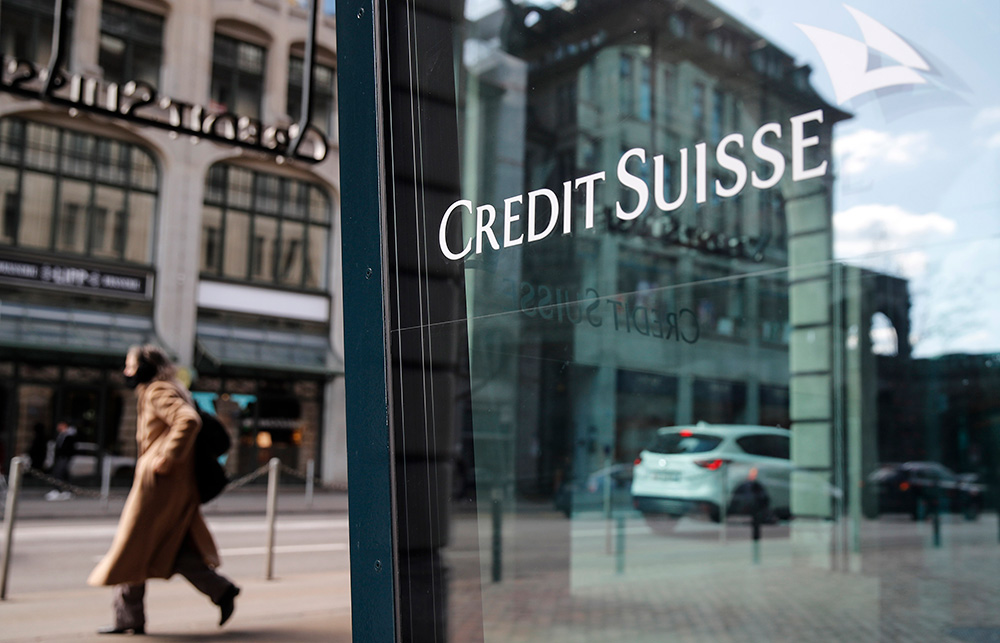
搅动华尔街的对冲基金Archegos Capital Management再爆惊人消息,预计将导致瑞士信贷损失50亿瑞士法郎(约合55亿美元),一次亏掉相当于投行部门5年的利润。
投资者也惩罚了该股票,周四苏黎世开盘股票便下跌了4.5%。
周四,丑闻缠身的瑞士银行通过强制可转债出售了2.03亿股股票。瑞信表示与比尔·黄旗下对冲基金相关交易尚未完全平仓,预测二季度可能出现6亿瑞士法郎(合6.56亿美元)的相关亏损。
出售股票之前的三个月里,瑞信已计入44.3亿瑞士法郎费用,导致出现7.57亿瑞士法郎的亏损,不过比最初担心的数额要少。
首席执行官高曦泰表示,纽约大宗经纪业务造成的损失“不可接受”,认为问题根源在于Archegos运作不透明。
“很明显,类似的家族办公室并没有像普通对冲基金一样披露头寸,”高曦泰告诉记者。“我们将向监管机构了解其他公司的管理方式。”
长期资本阴影再现
上个月底,摩根大通预计银行业与Archego相关的损失或将增加到100亿美元。不过,野村和摩根士丹利等交易对家都估计,他们各自的损失与瑞信相比要少很多。
“这次事件很特殊。从规模和后果而言,银行业上次遇到类似的情况还是长期资本管理公司(LTCM),”周四,瑞信首席财务官大卫·马瑟斯谈到上世纪90年对冲基金长期资本崩溃时对分析师表示。
尽管一季度承销业务激增,投行业务表现强劲,瑞信还是启动了战略评估以降低投行部门的杠杆率和资产规模。
瑞信表示,今年引发Archegos灾难的大宗经纪业务可能将缩减三分之一,只负责最重要的客户,不过相关客户与其他业务有很大重叠。
大宗服务业务的吸引力向来不大。“我们从来没觉得这块业务回报率很高,”高曦泰表示。
瑞信发行了两种可转换为约8.3%流通股的票据以支撑资产负债表。预计可筹集约17亿瑞士法郎净收入,也确保覆盖亏损的资本远高于偿付能力监管的最低门槛。
“我们希望不用再讨论资本状况,”瑞信首席执行官对记者表示。他补充说,此举也能避免瑞信受市场动荡和通胀担忧的影响。
Greensill Capital倒闭后,Archegos迅速爆出亏损消息,也迫使瑞信清算投资基金,目前与资不抵债的供应链金融公司相关资产已高达100亿美元。
如今,在曾经所谓安全的短期投资方面,客户损失可能高达数十亿美元。尽管如此,管理层仍表示出现赎回潮的可能性不大。首席财务官马瑟斯表示,3月该公司三个财富管理部门的净新增资产均为正值,此前公司已撤出对Greensill funds的投资。
瑞信并未排除在损益表中额外费用增加的可能性,当季已出现3000万美元的减记,主要涉及向Greensill提供的过桥贷款。
更令投资者不安的是,周四瑞士金融监管机构FINMA表示,因瑞信牵扯到Archegos和Greensill崩盘已对其启动强制执行程序。
大清扫
本月早些时候,公司对相关交易逐一展开调查,取消了高管奖金,拟议股息削减了三分之二。投行部门负责人布莱恩•陈和风险与合规部主管劳拉•华纳也被迫离职。
然而,两人离任对高曦泰的影响相当负面。之前他曾亲手提拔陈(Chin),还宣布今年夏天华纳的职责范围将覆盖一项增效计划,目标是明年起每年节省最多4.5亿瑞士法郎。现在看来,该项增效计划对公司未来非常关键,因为Archegos相关的损失相当于10年的资金储备。
之后不久,顽强的高曦泰发誓要与5月新上任的董事长安东尼奥•奥尔塔-奥索里奥一起,牢牢掌控局面。
安东尼奥•奥尔塔-奥索里奥目前在劳埃德银行集团担任首席执行官,很适合这份新工作。迄今为止今年全球最大的两起金融事件中,瑞信都遭到波及。
瑞信的命运迅速恶化。就在六个月前,一直苦苦忍受的股东还对公司前景抱有光明的希望。由于三季度业绩稳健,去年10月底瑞信决定依照瑞士监管机构的要求,支付2019年扣下的剩余一半股息。
瑞信也恢复了因疫情暂停的股票回购,打算今年再拨出10亿瑞士法郎。此后股价一路大涨,幅度高达50%,但今年早些时候,暂停进一步回购股票等消息不断传出,涨势逐渐回落。
截至4月下旬,瑞信过去半年的涨幅已基本抹平。(财富中文网)
更新,2021年4月22日:本文已更新来自瑞信的评论。
搅动华尔街的对冲基金Archegos Capital Management再爆惊人消息,预计将导致瑞士信贷损失50亿瑞士法郎(约合55亿美元),一次亏掉相当于投行部门5年的利润。
投资者也惩罚了该股票,周四苏黎世开盘股票便下跌了4.5%。
周四,丑闻缠身的瑞士银行通过强制可转债出售了2.03亿股股票。瑞信表示与比尔·黄旗下对冲基金相关交易尚未完全平仓,预测二季度可能出现6亿瑞士法郎(合6.56亿美元)的相关亏损。
出售股票之前的三个月里,瑞信已计入44.3亿瑞士法郎费用,导致出现7.57亿瑞士法郎的亏损,不过比最初担心的数额要少。
首席执行官高曦泰表示,纽约大宗经纪业务造成的损失“不可接受”,认为问题根源在于Archegos运作不透明。
“很明显,类似的家族办公室并没有像普通对冲基金一样披露头寸,”高曦泰告诉记者。“我们将向监管机构了解其他公司的管理方式。”
长期资本阴影再现
上个月底,摩根大通预计银行业与Archego相关的损失或将增加到100亿美元。不过,野村和摩根士丹利等交易对家都估计,他们各自的损失与瑞信相比要少很多。
“这次事件很特殊。从规模和后果而言,银行业上次遇到类似的情况还是长期资本管理公司(LTCM),”周四,瑞信首席财务官大卫·马瑟斯谈到上世纪90年对冲基金长期资本崩溃时对分析师表示。
尽管一季度承销业务激增,投行业务表现强劲,瑞信还是启动了战略评估以降低投行部门的杠杆率和资产规模。
瑞信表示,今年引发Archegos灾难的大宗经纪业务可能将缩减三分之一,只负责最重要的客户,不过相关客户与其他业务有很大重叠。
大宗服务业务的吸引力向来不大。“我们从来没觉得这块业务回报率很高,”高曦泰表示。
瑞信发行了两种可转换为约8.3%流通股的票据以支撑资产负债表。预计可筹集约17亿瑞士法郎净收入,也确保覆盖亏损的资本远高于偿付能力监管的最低门槛。
“我们希望不用再讨论资本状况,”瑞信首席执行官对记者表示。他补充说,此举也能避免瑞信受市场动荡和通胀担忧的影响。
Greensill Capital倒闭后,Archegos迅速爆出亏损消息,也迫使瑞信清算投资基金,目前与资不抵债的供应链金融公司相关资产已高达100亿美元。
如今,在曾经所谓安全的短期投资方面,客户损失可能高达数十亿美元。尽管如此,管理层仍表示出现赎回潮的可能性不大。首席财务官马瑟斯表示,3月该公司三个财富管理部门的净新增资产均为正值,此前公司已撤出对Greensill funds的投资。
瑞信并未排除在损益表中额外费用增加的可能性,当季已出现3000万美元的减记,主要涉及向Greensill提供的过桥贷款。
更令投资者不安的是,周四瑞士金融监管机构FINMA表示,因瑞信牵扯到Archegos和Greensill崩盘已对其启动强制执行程序。
大清扫
本月早些时候,公司对相关交易逐一展开调查,取消了高管奖金,拟议股息削减了三分之二。投行部门负责人布莱恩•陈和风险与合规部主管劳拉•华纳也被迫离职。
然而,两人离任对高曦泰的影响相当负面。之前他曾亲手提拔陈(Chin),还宣布今年夏天华纳的职责范围将覆盖一项增效计划,目标是明年起每年节省最多4.5亿瑞士法郎。现在看来,该项增效计划对公司未来非常关键,因为Archegos相关的损失相当于10年的资金储备。
之后不久,顽强的高曦泰发誓要与5月新上任的董事长安东尼奥•奥尔塔-奥索里奥一起,牢牢掌控局面。
安东尼奥•奥尔塔-奥索里奥目前在劳埃德银行集团担任首席执行官,很适合这份新工作。迄今为止今年全球最大的两起金融事件中,瑞信都遭到波及。
瑞信的命运迅速恶化。就在六个月前,一直苦苦忍受的股东还对公司前景抱有光明的希望。由于三季度业绩稳健,去年10月底瑞信决定依照瑞士监管机构的要求,支付2019年扣下的剩余一半股息。
瑞信也恢复了因疫情暂停的股票回购,打算今年再拨出10亿瑞士法郎。此后股价一路大涨,幅度高达50%,但今年早些时候,暂停进一步回购股票等消息不断传出,涨势逐渐回落。
截至4月下旬,瑞信过去半年的涨幅已基本抹平。(财富中文网)
更新,2021年4月22日:本文已更新来自瑞信的评论。
The stunning implosion of Archegos Capital Management, whose speculative bets roiled Wall Street, is now expected to cost Credit Suisse an even 5 billion francs ($5.5 billion), wiping out in one fell swoop five years of profits at its investment banking division.
Investors punished the stock, sending shares down 4.5% at the open Thursday in Zurich.
The scandal-plagued Swiss lender, which sold 203 million shares via mandatory convertibles on Thursday, said it had not yet fully unwound trades connected with Bill Hwang’s hedge fund and forecast further related headwinds of 600 million francs ($656 million) for the second quarter.
This comes on top of the 4.43 billion francs charge booked in the first three months of the year, pushing the group 757 million francs into the red, albeit less than initially feared.
Chief executive Thomas Gottstein called the losses generated by its New York prime brokerage operation "unacceptable" but blamed the opaque nature of Archegos for the problem.
“It's clear that a family office like that did not disclose positions like a normal hedge fund would do," Gottstein told reporters. "We will also learn from the regulators how other firms had managed."
Echoes of long-term capital
At the end of last month, JP Morgan raised its forecast for the banking sector’s collective Archego losses to $10 billion. Rivals Nomura and Morgan Stanley have estimated their respective hit to be a fraction of Credit Suisse’s, however.
“It is an exceptional event. I think the last time the industry has seen anything like this was LTCM in terms of its size and consequence,” Credit Suisse chief financial officer David Mathers told analysts on Thursday, referring to the collapse in the 1990s of hedge fund Long-Term Capital Management.
Despite an otherwise strong underlying Q1 performance in investment banking led by a surge in underwriting, Credit Suisse initiated a strategic review with the aim of slimming the division’s leverage and assets.
The prime brokerage activities responsible for the Archegos disaster could shrink by a third over the course of this year to focus only on the bank’s most important clients who have large overlaps across the rest of its operations, it said.
Prime services were never a very attractive part of the business. "It is definitely not a business per se that we ever felt was extremely high returning," Gottstein said.
Credit Suisse shored up its balance sheet by issuing two notes convertible into roughly 8.3% of its outstanding shares. This will raise an estimated 1.7 billion francs in net proceeds and bolster its loss-absorbing capital well above regulatory minimum thresholds for solvency.
"We wanted to take the whole capital debate off the table," the Credit Suisse CEO told reporters, adding it would also protect the bank against volatile markets and inflationary fears.
The Archegos loss followed swiftly on the heels of the collapse of Greensill Capital, forcing Credit Suisse to liquidate investment funds, whose $10 billion in assets were linked to the now insolvent supply-chain finance firm.
Clients now face potentially billions in losses on what were supposedly safe, short-term investments. Nonetheless, management said there was no indication the bank might face a wave of redemptions. Net new assets in each of its three wealth management divisions were positive in March, according to finance chief Mathers, after it froze investors out from the Greensill funds.
Credit Suisse didn’t rule out additional charges to its income statement, either, already booking in a $30 million write-down in the quarter related to a bridge loan to Greensill.
Adding to investor jitters, the Swiss financial watchdog, FINMA, said on Thursday it has opened enforcement proceedings against the bank for its role in the Archegos and Greensill collapses.
Cleaning house
Earlier this month, investigations were launched into each affair, bonuses for the C-suite were eliminated, and the proposed dividend slashed by two-thirds. It also cost the job of both the division’s head, Brian Chin, and risk and compliance boss Lara Warner.
Their departures, however, cast a negative light on Gottstein. He promoted Chin to the role and expanded Warner’s remit this summer as part of an efficiency plan designed to save up to 450 million francs annually from next year. This looks to be a now fateful decision as Archegos-related losses will eat up a decade of those planned savings.
A defiant Gottstein vowed shortly afterward to stay on to right the ship together with the new chairman of the board come May, António Horta-Osório.
The current CEO of Lloyds Banking Group has his work cut out for him: Amid the two single biggest global financial debacles so far this year, Credit Suisse found itself in the middle of both.
Credit Suisse's fortunes have soured quickly. Only six months ago, the outlook was brightening for the bank’s long-suffering shareholders. On the back of solid third-quarter results, it decided at the end of October to pay out the remaining half of the 2019 dividend cut at the request of Swiss regulators.
It simultaneously resumed share buybacks suspended because of the pandemic and earmarked a further billion francs for this year. The move marked the beginning of a 50% surge in the stock price, but the rally petered out earlier this year amid a steady stream of news, including the suspension of further stock repurchases.
As of late April, Credit Suisse has relinquished almost all its gains made in the past half-year.
Update, April 22, 2021: This article has been updated with comments from Credit Suisse throughout.






